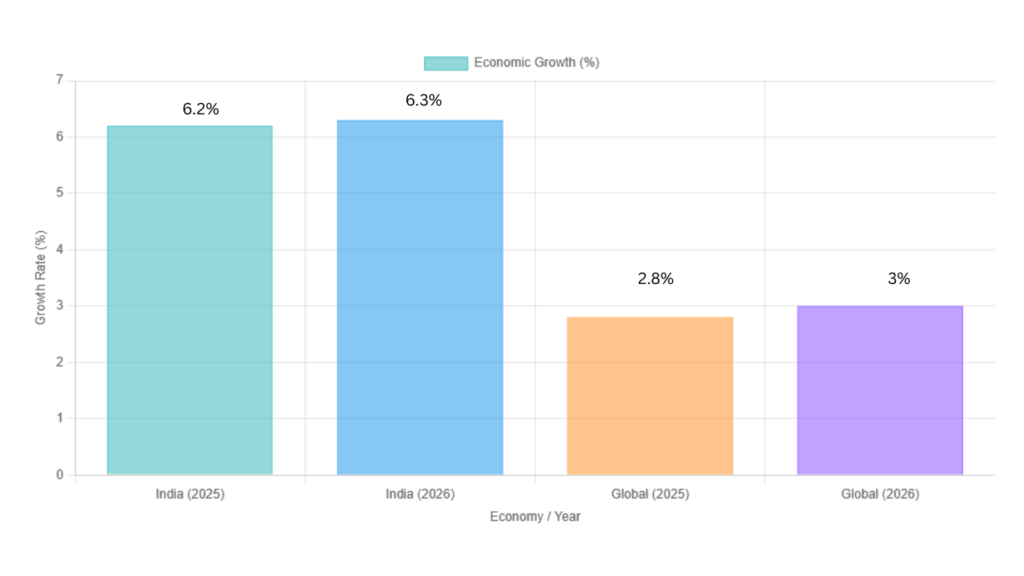You don’t have to look far to understand the significance of this moment. In 2025, India became the 4th largest economy in the world, overtaking Japan in terms of nominal GDP. For decades, India carried the tag of a “developing economy,” climbing its way up the ranks in a global system largely dominated by Western and East Asian powers. But in 2025, that label is finally outdated.
India has officially overtaken Japan to become the world’s fourth-largest economy by nominal GDP, according to the International Monetary Fund (IMF). That’s not just a headline—it’s a turning point.
The Numbers Behind the Milestone
According to IMF projections cited by Business Standard, India’s nominal GDP is expected to hit $4.3 trillion in FY25, putting it just ahead of Japan, whose GDP is likely to shrink slightly due to yen depreciation and slower growth.

To be precise, the IMF projects:
- India’s GDP: $4.33 trillion
- Japan’s GDP: $4.31 trillion
This means India now ranks behind only the United States, China, and Germany, and if growth trends continue, even Germany might be within striking distance in a few years.
Read more: What You Need to Know About Capital Gains and Property Tax When Selling Property in India 2025
What Drove India’s Economic Leap?
India’s rise to the fourth spot wasn’t accidental—it’s the result of consistent structural reforms, macroeconomic stability, and a booming services and manufacturing sector. Let’s break it down.
1. Policy Reforms
From the rollout of GST and insolvency reforms to initiatives promoting digitization and ease of doing business, India has systematically restructured its economy over the last decade. These moves have improved formalization, widened the tax base, and increased foreign investor confidence.
2. Demographic Advantage
With a median age under 30, India boasts one of the youngest workforces in the world. This has supported both domestic consumption and productivity, especially in IT services, fintech, and manufacturing.
3. Resilience Amid Global Volatility
While much of the world grappled with post-pandemic slowdowns, supply chain crises, and inflation shocks, India’s economy stayed remarkably stable, thanks to prudent fiscal management and strong domestic demand.
Anand Mahindra’s Perspective: “An Audacious Dream Turned Reality”
Business leader Anand Mahindra perhaps summed it up best when he reacted to the news:
“From an audacious dream to reality. We must now focus on per capita GDP. Growth must touch every citizen.”
He’s not wrong. Because while India’s aggregate GDP is now among the world’s top four, its per capita income still trails many developed and emerging economies. If the goal is prosperity—not just size—then inclusive growth must be the next frontier.
The Bigger Picture: What This Means for the World
India overtaking Japan is not just symbolic—it signals a geopolitical and economic power shift. Here’s why this matters:
- India is increasingly influencing global supply chains, especially as Western firms de-risk from China.
- Multinationals are betting big on India, not just as a market but as a manufacturing base (think Apple, Tesla).
- Geopolitically, India’s growing economic weight gives it a bigger seat at the global table—from G20 negotiations to climate talks.
Looking Ahead: Can India Become the 3rd Largest Economy?
Yes—if the momentum holds.
According to IMF forecasts, India could surpass Germany and become the world’s third-largest economy by 2027 or 2028. But that future depends on a few key levers:
- Boosting manufacturing and exports
- Investing in education and skill development
- Addressing infrastructure and urban planning bottlenecks
- Tackling inequality and enhancing per capita income
Our Thoughts
India’s climb to the fourth-largest economy in the world isn’t just about numbers—it’s a testament to decades of policy shifts, entrepreneurial grit, and demographic momentum. But with great power comes great responsibility.
The next big leap isn’t about overtaking another economy. It’s about making sure that every Indian, in every state, feels the benefit of this growth.






Leave a Reply